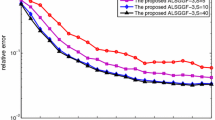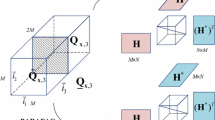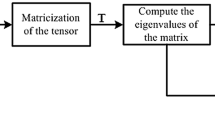Abstract
In this paper, we propose a new family of algorithms for underdetermined blind identification based on the second generating function (SGF). For the real case, the proposed algorithm first takes advantage of the partial derivatives of the SGF of the observation signals to construct a tensor and then reconstructs this tensor by grouping the parallel factors. The reconstructed tensor, which expands the length of several dimensions of the original tensor, transforms the underdetermined case into an overdertermined or determined case when \(({M^2} + M)/2 \ge N\), where M is the number of sensors and N is the number of sources. Thus, obtaining the estimation of the mixing matrix by decomposing the reconstructed tensor results in the performance improvement. The analysis of the uniqueness of tensor decomposition and the complex analysis show that the proposed algorithm relaxes the limitation of the maximal number of sources and owns lower computational complexity order compared with the conventional ALESCAF algorithm. We also extend the proposed algorithm to the complex case by complex-to-real transformation. Simulation results verify the effectiveness of the proposed algorithms and show that the proposed algorithms are preferred when the signal-to-noise ratio is higher than 5 dB.







Similar content being viewed by others
References
L. Albera, A. Ferreol, P. Comon et al., Blind identification of overcomplete mixtures of sources (BIOME). Lin. Algebra Appl. 391, 1–30 (2004)
P. Bofill, M. Zibulevsky, Underdetermined blind source separation using sparse representations. Signal Process. 81(11), 2353–2362 (2001)
Y. Cai, D. Liu, Multiuser detection using the Taguchi method for DS-CDMA systems. IEEE Trans. Wirel. Commun. 4(4), 1594–1607 (2005)
J.D. Carroll, J.J. Chang, Analysis of individual differences in multidimensional scaling via n-way generalization of Eckart–Young decomposition. Psychometrika 35(3), 283–319 (1970)
P. Chevalier, L. Albera, A. Ferréol, P. Comon, On the virtual array concept for higher order array processing. IEEE Trans. Signal Process. 53(4), 1254–1271 (2005)
P. Comon, C. Jutten et al., Handbook of Blind Source Separation: Independent Component Analysis and Applications (Academic press, New York, 2010)
P. Comon, X. Luciani, A.L.F. de Almeida, Tensor decompositions, alternating least squares and other tales. J. Chemom. 23, 393–405 (2009)
P. Comon, M. Rajih, Blind identification of under-determined mixtures based on the characteristic function. Signal Process. 86(9), 2271–2281 (2006)
P. Comon, M. Rajih, Blind identification of complex underdetermined mixtures, in Proceedings of ICA Conference (Granada, 2004), pp. 105–112
A.L.F. de Almeida, X. Luciani, A. Stegeman, P. Comon, CONDFAC decomposition approach to blind identification of underdetermined mixtures based on generating function derivatives. IEEE Trans. Signal Process. 60(11), 5698–5713 (2012)
W. Feller, An Introduction to Probability Theory and Its Applications (Wiley, New York, 1973)
R.A. Harshman, Determination and proof of minimum uniqueness conditions for PARAFAC-1. UCLA Working Papers in Phonet. vol. 22, pp. 111–117 (1972)
R.A. Harshman, Foundations of the Parafac Procedure: Models and Conditions for an Explanatory Multimodal Factor Analysis. UCLA Working Papers in Phonet, vol. 16, pp. 1–84 (1970)
M.M. Hossain, B.E. Levy, D. Thapa, A.L. Oldenburg, C.M. Gallippi, Blind source separation-based motion detector for imaging super-paramagnetic iron oxide (SPIO) particles in magnetomotive ultrasound imaging. IEEE Trans. Med. Imaging 37(10), 2356–2366 (2018)
T. Jiang, N.D. Sidiropoulos, Kruskal’s permutation lemma and the identification of CANDECOMP/PARAFAC and bilinear models with constant modulus constraints. IEEE Trans. Signal Process. 52(9), 2625–2636 (2004)
A.M. Kagan, Y.V. Linnika, C.R. Rao, Characterization Problems in Mathematical Statistics (Wiley, New York, 1973)
A. Karfoul, L. Albera, G. Birot, Blind underdetermined mixture identification by joint canonical decomposition of HO cumulants. IEEE Trans. Signal Process. 58(2), 638–649 (2010)
A. Karfoul, L. Albera, D.L. Lathauwer, Iterative methods for the canonical decomposition of multi-way arrays: application to blind underdetermined mixture identification. Signal Process. 91(8), 1789–1802 (2011)
S. Kim, C.D. Yoo, Underdetermined blind source separation based on subspace representation. IEEE Trans. Signal Process. 57(7), 2604–2614 (2009)
J.B. Kruskal, Three-way arrays: rank and uniqueness of trilinear decompositions, with application to arithmetic complexity and statistics. Linear Algebra Appl. 18, 95–138 (1977)
M. Küdhne, R. Togneri, S. Nordholm, A new evidence model for missing data speech recognition with applications in reverberant multisource environments. IEEE Trans. Audio Speech Lang. Process. 19(2), 372–384 (2011)
D.L. Lathauwer, J. Castaing, Blind identification of underdetermined mixtures by simultaneous matrix diagonalization. IEEE Trans. Signal Process. 56(3), 1096–1105 (2008)
D.L. Lathauwer, J. Castaing, J.F. Cardoso, Fourth-order cumulant based blind identification of underdetermined mixtures. IEEE Trans. Signal Process. 55(6), 2965–2973 (2007)
D.L. Lathauwer, B.D. Moor, J. Vandewalle, On the best rank-1 and rank-(\(R_1\), \(R_2\),\(\cdots \), \(R_N\)) approximation of higher-order tensors. SIAM J. Matrix Anal. Appl. 21, 1324–1342 (2000)
H. Lin, T. Thaiupathump, S.A. Kassam, Blind separation of complex I/Q independent sources with phase recovery. IEEE Signal Process. Lett. 12(5), 419–422 (2005)
X. Luciani, A.L.F. de Almeida, P. Comon, Blind identification of underdetermined mixtures based on the characteristic function: the complex case. IEEE Trans. Signal Process. 59(2), 540–553 (2011)
M. Rajih, P. Comon, Blind identification of under-determined mixtures based on the characteristic function: Influence of the knowledge of source PDF’s, in Proceedings of 1st IEEE International Workshop on Computational Advances in Multi-Sensor Adaptive Processing (Puerto Vallarta, 2005), pp. 133–136
M. Rajih, P. Comon, R. Harshman, Enhanced line search: a novel method to accelerate PARAFAC. SIAM J. Matrix Anal. Appl. 30(3), 1148–1171 (2008)
N.D. Sidiropoulos, R. Bro, On the uniqueness of multilinear decomposition of N-way arrays. J. Chemom. 14, 229–239 (2000)
Q. Su, Y. Shen, W. Jian et al., Underdetermined blind identification for uniform linear array by a new time-frequency method. Circuits Syst. Signal Process. 36(1), 99–118 (2017)
Q. Su, Y. Shen, Y. Wei et al., SSP-based UBI algorithms for uniform linear array. Circuits Syst. Signal Process. 36(10), 4077–4096 (2017)
P. Tichavský, Z. Koldovský, Weight adjusted tensor method for blind separation of underdetermined mixtures of nonstationary sources. IEEE Trans. Signal Process. 59(3), 1037–1047 (2011)
L. Yang, H. Zhang, Y. Cai, A low-complexity PARAFAC decomposition for underdetermined blind system identification with complex mixtures. Circuits Syst. Signal Process. 37(11), 4842–4860 (2018)
Acknowledgements
This work was supported by the National Natural Science Foundation of China under Grant Nos. 61671472, 61172061, and 61201242 and the Natural Science Foundation of Jiang Su Province in China under Grant Nos. BK20160079, BK20181335, and BK2012057.
Author information
Authors and Affiliations
Corresponding author
Additional information
Publisher's Note
Springer Nature remains neutral with regard to jurisdictional claims in published maps and institutional affiliations.
Appendix: Proof of that the Limitation of N in (15) is More Relaxed Compared to the ALESCAF Algorithm
Appendix: Proof of that the Limitation of N in (15) is More Relaxed Compared to the ALESCAF Algorithm
The number of sources of the ALESCAF algorithm has the following limitation:
If \(S < N\), we first compare the right side of the first row in (31) with that in (15) and have
(32) suggests that when \(M\ge 2\), the upper bound of N in the first row of (15) is more relaxed than that of (31).
As for the case with \(S\ge N\), we compare the right side of the second row in (31) with that in (15) and get
It can be inferred from (33) that the second row in (15) has more relaxed upper bound of N than that in (31). In conclusion, it is true that compared to the ALESCAF algorithm, the limitation on N in (15) is more relaxed.
Rights and permissions
About this article
Cite this article
Su, Q., Wei, Y., Xu, K. et al. Using Derivatives of Second Generating Function for Underdetermined Blind Identification. Circuits Syst Signal Process 39, 4578–4595 (2020). https://doi.org/10.1007/s00034-020-01385-y
Received:
Revised:
Accepted:
Published:
Issue Date:
DOI: https://doi.org/10.1007/s00034-020-01385-y




